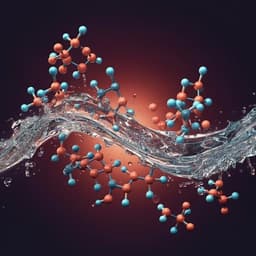
Engineering and Technology
Self-peeling of frozen water droplets upon impacting a cold surface
W. Fang, F. Zhu, et al.
Explore an innovative passive ice removal method that utilizes thermal-mechanical stress to enable self-peeling of frozen droplets on cold hydrophobic surfaces, as revealed by researchers Wen-Zhen Fang, Fangqi Zhu, Lailai Zhu, Wen-Quan Tao, and Chun Yang. This breakthrough contrasts with traditional methods, showcasing complete self-peeling and promising implications for anti-icing surface design.
~3 min • Beginner • English
Introduction
Icing severely affects the performance and safety of many engineering systems. When supercooled water droplets impact chilled surfaces, they can freeze and adhere, complicating de-icing. Active removal via heating or mechanical means is energy intensive and intrusive. Passive approaches based on superhydrophobicity can reduce contact time and enable droplet rebound to avoid freezing, but this mechanism fails on sufficiently cold substrates where nucleation occurs despite reduced contact time. Prior studies suggest that thermal-mechanical stresses generated during rapid cooling and solidification can fracture solids or break substrate bonding. This work investigates whether such stresses can be harnessed to achieve passive, self-driven delamination of ice formed by impacting water droplets, identifies the conditions (subcooling, impact parameters, wettability) under which self-peeling occurs, and develops a thermomechanical model to predict peeling onset and post-onset bending/deflection.
Literature Review
Superhydrophobic coatings provide passive ice-mitigation by promoting droplet rebound and shortened contact times, reducing cooling below nucleation thresholds (e.g., Bird et al. 2013; Liu et al. 2014; Gauthier et al. 2015; Maitra et al. 2014; Zhang et al. 2018, 2020). However, at deep subcooling, droplets nucleate and adhere. Thermal-mechanical stress in other materials during rapid cooling/solidification has led to curling, self-peeling, fractures, and delamination (e.g., liquid metal splats curling, molten tin self-peeling, alkane droplet fractures/delamination). For water on hydrophilic surfaces, impacts can produce cracking and fragmentation in the frozen droplet (Ghabache et al. 2016; Song et al. 2020). Despite these indications, experimental demonstration of using thermal-mechanical stress for passive ice removal had not been clearly shown. Ice adhesion is known to correlate with wettability and 1 + cosθ on nominally smooth surfaces (Meuler et al. 2010), and adhesion depends strongly on surface treatment, whereas ice cohesion is set by the surface energy of ice. These prior findings motivate exploring regimes where adhesion is sufficiently weak relative to cohesive energy to favor peeling over cracking.
Methodology
Experiments were performed in a nitrogen-filled enclosed chamber (Supplementary Fig. 1). Individual deionized water droplets at room temperature with initial diameters D0 ≈ 2.2–3.4 mm were released from heights H = 9–90 cm to impact a copper substrate held at controlled temperatures Ts between −10 °C and −47 °C. The substrate wettability was tuned to static contact angles θ between 22° (hydrophilic) and 119° (hydrophobic) via surface treatment/coating. Side and top views recorded the spreading, freezing, and post-freezing behavior. Representative case: D0 = 2.2 mm, H = 45 cm, Ts = −43 °C, θ = 119° (coated hydrophobic) versus θ = 62° (uncoated hydrophilic). Post-freezing removal was tested by applying nitrogen gas flow at ~2 m s−1. A phase map of behaviors (complete peeling, partial peeling, no peeling/cracking, cracking) was constructed versus ΔT = T0 − Ts and 1 + cosθ.
A thermal-mechanical model was developed. The freezing droplet is idealized as a two-layer cylinder: a water film above a growing ice disk of thickness h(t). Balancing diffusive heat flux and freezing rate yields h(t) = √(2 λ ΔT t/(ρi L)) and freezing time τf = ρi L h0/(2 λ ΔT), where ρi is ice density, λ its thermal conductivity, L latent heat, and ΔT = T0 − Ts. Stefan numbers St = Cpi ΔT/L ≈ 0.05–0.27 indicate thermal diffusion is faster than solidification, so during freezing (t ≤ τf) a quasi-steady linear temperature profile T(z,t) across ice is assumed with T(0,t) = Ts and T(h(t),t) = T0. After complete freezing (t > τf), the top boundary is taken adiabatic and transient 1D heat diffusion in the ice thickness h0 is solved via separation of variables to obtain T(z,t). Using Kirchhoff–Love plate theory, the radial stress is σrr = Ei α [T(z,t) − T0]/(ν − 1), with Ei, ν, α the Young’s modulus, Poisson’s ratio, and thermal expansion coefficient of ice. The thermal elastic moment density per unit azimuthal length is M(t) = ∫0^{h(t)} σrr z dz. This gives M(t) growing linearly during freezing: M(t) = [Ei α ΔT t]/[3(1 − ν) ρi L], and approaching an asymptotic limit M∞ = Ei α ΔT h0/[2(1 − ν)] post-freezing. A linearized post-freezing form near t → τf is M(t) ≈ [Ei α/(1 − ν)] [ΔT (h0/6 + κ (t − τf))]. Peeling onset is assumed when M(t) exceeds a critical adhesive moment density M*, related to interfacial toughness γ between ice and substrate; solving M(τp) = M* (assuming τp ≤ τf) yields τp = [3(1 − ν) ρi L M*]/[Ei α (ΔT)^2]. Ice bending after peeling initiation is analyzed by treating the ice bottom as the neutral plane; the deflection w(r,t) obeys w(r,t) = M(t)/[2 B (1 + ν)] with flexural rigidity B = E h/[3(1 − ν^2)] and edge deflection δ(t) = M(t) Dmax/[8 B (1 + ν)]. The maximum spreading diameter is correlated as Dmax/D0 = C0 We^{1/4} with C0 ≈ 0.87; We = 2 ρw g D0 H/γw. Early-time post-peeling deflection scales as δ/D0 = K [((t − τr)/τd)^2 − (t − τr)/τd], with τd = D0^2/K and K = 81 g ρw D0^2 α ΔT/(16 γw − α). A curvature-based indicator κD = M/D0^3 was proposed to predict complete vs partial peeling; complete peeling occurs when κD exceeds a threshold (~0.03) that weakly increases with 1 + cosθ.
Key Findings
- Phenomenology: On hydrophobic coated copper (θ = 119°), droplets that froze exhibited self-peeling followed by easy removal by a ~2 m s−1 nitrogen jet; on hydrophilic copper (θ = 62°), frozen droplets cracked and remained stuck. In a representative case (D0 = 2.2 mm, H = 45 cm, Ts = −43 °C), the lamella reached Dmax ≈ 8 mm at t ≈ 1.8 ms. On the hydrophobic surface, upward bending started at t ≈ 42.6 ms and complete self-peeling occurred by t ≈ 49.6 ms, with maximum edge deflection δ ≈ 100 μm; on the hydrophilic surface, basin-like thinning preceded cracking initiated at t ≈ 17.6 ms.
- Behavior map: For hydrophobic surfaces (θ ≈ 104–119°), decreasing ΔT from >40 K to ~35 K caused a transition from complete peeling to partial peeling to no peeling/cracking. For hydrophilic surfaces (θ ≈ 22–62°), a critical ΔT ≈ 29 K separates no cracking (ΔT < ~29 K) from cracking (ΔT > ~29 K) and this threshold is independent of θ within the explored range.
- Energy balance explanation: Ice cohesive energy (surface energy γi ≈ 0.11 J m−2) is approximately constant over the studied temperature range. Ice–substrate adhesion depends strongly on surface treatment: for hydrophilic copper γs ≈ 1.8 J m−2, so cracking (breaking ice cohesion) is energetically favored over peeling (against strong adhesion); for hydrophobic coated surfaces γs ≈ 0.02 J m−2, much weaker than cohesion, favoring peeling over cracking. Ice adhesion on smooth surfaces increases roughly linearly with 1 + cosθ, consistent with observations.
- Peeling onset scaling: The peeling time τp scales inversely with the square of subcooling, τp ∝ (ΔT)−2, as derived from the thermal-moment model and confirmed experimentally for D0 = 2.2, 2.8, and 3.4 mm (data collapse when plotting τp/Dmax vs ΔT).
- Bending/deflection: Post-peeling edge deflection δ scales with time according to the derived quadratic-minus-linear law in normalized time, capturing measured deflection evolution after freezing; most deflection occurs in the post-frozen period when temperature homogenizes.
- Predictive criterion: A curvature indicator κD = M/D0^3 demarcates complete vs partial peeling, with a threshold ~0.03 that weakly increases with 1 + cosθ. Larger ΔT and higher impact height H (higher We) promote complete peeling by increasing κD.
- Practical implication: Frozen droplets on sufficiently cold hydrophobic (smoothly coated) surfaces can self-peel and be removed by very weak air flows, offering a passive de-icing pathway.
Discussion
The findings demonstrate that thermal-mechanical stresses generated during rapid cooling and solidification of impacting droplets can be harnessed to passively delaminate ice from hydrophobic surfaces. The competition among thermal contraction, ice cohesion, and ice–substrate adhesion governs whether the frozen droplet cracks (hydrophilic, strong adhesion) or peels (hydrophobic, weak adhesion). The thermomechanical model captures the time evolution of thermal moments, predicts the ΔT−2 scaling of peeling onset, and explains post-peeling bending dynamics. The curvature-based criterion provides a simple design metric linking substrate wettability (1 + cosθ), subcooling, and impact conditions to de-icing outcomes. While more hydrophobicity generally promotes peeling through reduced adhesion, micro/nanotexturing in superhydrophobic surfaces can paradoxically increase ice adhesion, suggesting careful balance between repellency and adhesion reduction is needed. The results are relevant for designing coatings and operating conditions for passive anti-icing/de-icing in aerospace, energy, and infrastructure, where even modest airflows could clear self-peeled ice.
Conclusion
This work experimentally reveals that frozen water droplets can self-peel from sufficiently cold hydrophobic surfaces after impact and that the peeled ice is easily removed by weak airflow. In contrast, on hydrophilic surfaces, frozen droplets tend to crack and remain adhered. A thermal-mechanical plate model quantifies the evolving thermal elastic moment, predicts the peeling onset time τp ∝ (ΔT)−2, describes post-peeling bending/deflection, and provides a curvature-based criterion (κD threshold ~0.03, weakly dependent on 1 + cosθ) that demarcates complete from partial peeling. These insights furnish practical guidance for engineering icephobic, low-adhesion coatings enabling passive de-icing.
Future work could: (i) investigate textured/superhydrophobic surfaces to reconcile repellency with minimized ice adhesion; (ii) examine other substrates and coatings to generalize the criterion; (iii) account for environmental factors (airflow, humidity, frost) and repeated icing cycles; and (iv) refine the mechanics with more detailed adhesion and fracture models for partial-peeling regimes.
Limitations
- Experimental scope: Copper substrates within Ts = −10 to −47 °C and θ = 22°–119° were studied; extrapolation to other materials, textures, or broader temperatures may differ.
- Environmental control: Tests were in a nitrogen-filled chamber; ambient humidity/frost effects were not explored.
- Model assumptions: Axisymmetric 1D through-thickness temperature; quasi-steady temperature during freezing (small Stefan numbers); adiabatic top boundary post-freezing; Tb ≈ Ts in the substrate; neglect of sensible heat relative to latent heat; linear elastic plate theory with the ice bottom as neutral plane; constant curvature during bending; peeling assumed to initiate before complete solidification (τp ≤ τf) for scaling derivations.
- Adhesion characterization: Adhesive moment density M* and interfacial toughness γ were treated parametrically; direct, independent measurements of adhesion during transient freezing were not reported.
- Hydrophilic delamination at higher ΔT (>~57–60 K), reported elsewhere, was outside the explored temperature range.
Related Publications
Explore these studies to deepen your understanding of the subject.







